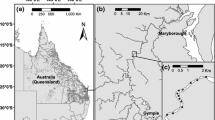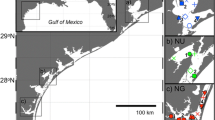Abstract
Information about animal movements has often been inferred from stable isotope analysis (SIA), but is dependent on animals assimilating site-specific isotopic signatures via diet. This potential weakness in ecological interpretation can be overcome by using other investigative tools that provide precise information about individual movement patterns. In this paper, we demonstrate the value of combining SIA with telemetry or mark-recapture data from trapping, electrofishing and remote detection of individuals to study the movement and feeding ecology of fishes in different habitats. In a fjord lake system in Newfoundland, Canada, juvenile Atlantic salmon delayed downstream migration (smolts) or actively moved into a large lake (parr) where they foraged for periods reflecting different life history strategies. In the Miramichi River (New Brunswick, Canada), SIA provided evidence of distinct foraging habitats (tributary versus large river). By tracking fish implanted with passive integrated transponder (PIT) tags, we distinguished between movements related to foraging versus seeking cool water refugia during high temperature events. Finally, site fidelity and limited mobility of slimy sculpin, a small benthic fish, was established where δ13C in muscle tissue showed a progressive enrichment downstream and where a median displacement of <10 m was estimated for sculpin tagged with PIT tags. Technological improvements have permitted non-destructive tissue sampling of wild fishes for SIA, and the tagging and remote detection of animals smaller than was previously possible. These advancements and the combination of investigative tools promise new insights into animal ecology.





Similar content being viewed by others
References
Baras E, Malbrouck C, Houbart M, Kestemont P, Mélard C (2000) The effect of PIT-tags on growth and physiology of age-0 cultured Eurasian perch Perca fluviatilis of variable size. Aquaculture 185:159–173
Barbin Zydlewski G, Haro A, Whalen KG, McCormick SD (2001) Performance of stationary and portable passive transponder detection systems for monitoring of fish movements. J Fish Biol 58:1471–1475
Bourgeois CE, O’Connell MF (1986) Observations on the seaward migration of Atlantic salmon smolts through a large lake as determined by radiotelemetry and Carlin tagging studies. Can J Zool 66:685–691
Brännäs E, Lundqvist H, Prentice E, Schmitz M, Brännäs K, Wilklund B-S (1994) Use of the Passive Integrated Transponder (PIT) in a fish identification and monitoring system for fish behavioural studies. Trans Am Fish Soc 123:395–401
Bridger CJ, Booth RK (2003) The effects of biotelemetry transmitter presence and attachment procedures on fish physiology and behavior. Rev Fish Sci 11:13–34
Bunn SE, Davies PM, Winning M (2003) Sources of organic carbon supporting the food web of an arid zone floodplain river. Freshw Biol 48:619–635
Carlin B (1955) Tagging of salmon smolts in the River Lagan. Institute of Freshwater Research, Drottningholm, Annual Report 1954, No. 36. pp 57–74
Castro-Santos T, Haro A, Walk S (1996) A passive integrated transponder (PIT) tag system for monitoring fishways. Fish Res 28:253–261
Chadwick EMP, Green JM (1985) Atlantic salmon (Salmo salar L.) production in a largely lacustrine Newfoundland watershed. Verhandlungen der Internationale Vereinigung für Theoretische und Angewandte Limnologie 22:2509–2515
Clegg SM, Kelly JF, Kimura M, Smith TB (2003) Combining genetic markers and stable isotopes to reveal population connectivity and migration patterns in a neotropical migrant, Wilson’s warbler (Wilsonia pusilla). Mol Ecol 12(4):819–30
Cooke SJ, Hinch SG, Wikelski M, Andrews RD, Kuchel LJ, Wolcott TG, Butler PJ (2004) Biotelemetry: a mechanistic approach to ecology. Trends Ecol Evol 19:334–343
Cunjak RA (1992) Comparative feeding, movements, and growth of Atlantic salmon (Salmo salar) parr from riverine and estuarine environments. Ecol Freshw Fish 1:26–34
Cunjak RA, Therrien J (1998) Inter-stage survival of wild juvenile Atlantic salmon, Salmo salar L. J Fish Manage Ecol 5:209–224
Cunjak RA, Caissie D, El-Jabi N, Hardie P, Conlon JH, Pollock TL, Giberson DJ, Komadina-Douthwright S (1993) The Catamaran Brook (New Brunswick) habitat research project: biological, physical and chemical conditions (1990–1992). Canadian Technical Report of Fisheries and Aquatic Sciences 1914
Curry RA, Currie SL, Bernatchez L, Saint-Laurent R (2004) The rainbow smelt, Osmerus mordax, complex of Lake Utopia: threatened or misunderstood? Environ Biol Fishes 69:153–166
Dempson JB, O’Connell MF, Shears M (1996) Relative production of Atlantic salmon from fluvial and lacustrine habitats estimated from analyses of scale characteristics. J Fish Biol 48:329–341
Dietrich JP (2001) The behaviour, survival and production of Atlantic salmon (Salmo salar L.) smolts in the Western Brook system. MSc thesis, University of New Brunswick
Doucett RR (1994) Stable isotope analysis of food pathways in the Miramichi River system, New Brunswick. M.Sc. thesis, University of Waterloo
Doucett RR, Hooper W, Power G (1999) Identification of anadromous and nonanadromous brook trout and their progeny in the Tabusintac River, New Brunswick, by means of multiple-stable-isotope analysis. Trans Am Fish Soc 128:278–288
Dussault C, Rodríguez MA (1997) Field trials of marking stream salmonids by dye injection and coded-wire-tagging. North Am J Fish Manage 17:451–456
Erkinaro J, Gibson RJ (1997) Interhabitat migration of juvenile Atlantic salmon in a Newfoundland river system. J Fish Biol 51:373–388
Erkinaro J, Julkunen M, Niemelä E (1998) Migration of juvenile Atlantic salmon Salmo salar in small tributaries of the subarctic river Teno, northern Finland. Aquaculture 168:105–119
Finlay JC (2001) Stable-carbon ratios of river biota: implications for energy flow in lotic food webs. Ecology 82:1052–1064
Forsberg BR, Araujo-Lima CARM, Martinelli LA, Victoria RL, Bonassi JA (1993) Autotrophic carbon sources for fish of the central Amazon. Ecology 74:643–652
Fry B (1991) Stable isotope diagrams of freshwater food webs. Ecology 72:2293–2297
Gibson RJ (1966) Some factors influencing the distribution of brook trout and young Atlantic salmon. J Fish Res Board Canada 23:1977–1980
Gibson RJ (1993) The Atlantic salmon in fresh water: spawning, rearing and production. Rev Fish Biol Fish 3:39–73
Gray MA (2003) Assessing non-point source pollution in agricultural regions of the upper St. John River basin using the slimy sculpin (Cottus cognatus). Ph.D. thesis, University of New Brunswick
Gray MA, Curry RA, Munkittrick KR (2002) Non-lethal sampling methods for assessing environmental impacts using a small-bodied sentinel fish species. Water Quality Res J Canada 37:195–211
Gray MA, Cunjak RA, Munkittrick KR (2004) Site fidelity of slimy sculpin: insights from stable isotope analysis. Can J Fish Aquatic Sci 61:1717–1722
Halvorsen M, Svenning MA (2000) Growth of Atlantic salmon parr in fluvial and lacustrine habitats. J Fish Biol 57:145–160
Hansen LP, Jonsson B, Doving KB (1984) Migration of wild and hatchery reared smolts of Atlantic salmon, Salmo salar L., through lakes. J Fish Biol 25:617–623
Hart PJB, Pitcher TJ (1969) Field trials of fish marking using a jet inoculator. J Fish Biol 1:383–385
Hershey AE, Pastor J, Peterson BJ, Kling GW (1993) Stable isotopes resolve the drift paradox for Baetis mayflies in an Arctic river. Ecology 74:2315–2325
Hesslein RH, Capel MJ, Fox DE, Hallard KA (1991) Stable isotopes of sulfur, carbon, and nitrogen as indicators of trophic level and fish migration in the Lower Mackenzie River Basin, Canada. Can J Fish Aquatic Sci 48:2258–2265
Hill J, Grossman GD (1987) Home range estimates for 3 North American stream fishes. Copeia 2:376–380
Hobson KA (1999) Tracing origins and migrations of wildlife using stable isotopes: a review. Oecologia 120:314–326
Hobson KA, Wassenaar LI (1997) Linking breeding and wintering grounds of neotropical migrant songbirds using stable hydrogen isotopic analysis of feathers. Oecologia 109:142–148
Hobson KA, Wassenaar LI, Taylor OR (1999) Stable isotopes (δD and δ13C) are geographic indicators of natal origins of monarch butterflies in east North America. Oecologia 120:397–404
Hutchings JA (1986) Lakeward migrations by juvenile Atlantic salmon, Salmo salar. Can J Fish Aquatic Sci 43:732–741
Hutchings JA, Jones M (1998) Life history variation and growth rate thresholds for maturity in Atlantic salmon, Salmo salar. Can J Fish Aquatic Sci 55(Suppl 1):22–47
Jardine TD, Cartwright DF, Dietrich JP, Cunjak RA (2005) Resource use by salmonids in riverine, lacustrine and marine environments: evidence from stable isotope analysis. Env Biol Fish 000–000 (in press)
Johnson WE, Groot C (1963) Observations on the migration of young sockeye salmon (Oncorhynchus nerka) through a large complex lake system. J Fish Res Board Canada 20:919–938
Jonsson B, Forseth T, Jensen AJ, Naesje TF (2001) Thermal performance of juvenile Atlantic salmon Salmo salar L. Funct Ecol 15:701–711
Keeley ER, Grant JWA (1995) Allometric and environmental correlates of territory size in juvenile Atlantic salmon (Salmo salar). Can J Fish Aquatic Sci 52:186–196
Kerekes JJ (1994) Western brook pond. In: Allan RJ (ed) The book of Canadian lakes. Canadian Association on water quality, Monograph no. 3, CCIW, Burlington, pp 284–293
Lund SG, Caissie D, Cunjak RA, Vijayan MM, Tufts BL (2002) The effects of environmental heat stress on heat shock mRNA and protein expression in Miramichi strain Atlantic salmon (Salmo salar) parr. Can J Fish Aquatic Sci 59:1553–1562
Lundqvist H, Clarke WC, Johansson H (1988) The Influence of precocious sexual maturation on survival to adulthood of river stocked Baltic salmon Salmo salar smolts. Holarctic Ecol 11:60–69
Martin-Smith KM, Armstrong JD (2002) Growth rates of wild stream-dwelling Atlantic salmon correlate with activity and sex but not dominance. J Anim Ecol 71:413–423
Matthews B, Mazumder A (2004) A critical evaluation of intrapopulation variation of δ13C and isotopic evidence of individual specialization. Oecologia 140:361–371
McCormick SD, Hansen LP, Quinn TP, Saunders RL (1998) Movement, migration and smolting in Atlantic salmon. Can J Fish Aquatic Sci 55(Suppl 1):77–92
Metcalfe NB, Fraser NHC, Burns MD (1999) Food availability and the nocturnal vs. diurnal foraging trade-off in juvenile salmon. J Anim Ecol 68:371–381
Morgan CR, Ringler NH (1992) Experimental manipulation of sculpin (Cottus cognatus) populations in a small stream. J Freshw Ecol 7:227–232
Munkittrick KR, McMaster ME, Van Der Kraak G, Portt C, Gibbons WN, Farwell A, Gray M (2000) Development of methods for effects-driven cumulative effects assessment using fish populations: Moose River project. Society of Environmental Toxicology and Chemistry (SETAC), Pensacola, FL, 256p
Peterson DP, Fausch KD (2003) Testing population-level mechanisms of invasion by a mobile vertebrate: a simple conceptual framework for stream salmonids. Biol Invasions 5:239–259
Power M, Power G (1994) Modeling the dynamics of smolt production in Atlantic salmon. Trans Am Fish Soc 123:535–548
Roussel J-M, Haro A, Cunjak RA (2000) Field-test of a new method for tracking small fishes in shallow rivers using passive integrated transponder (PIT) technology. Can J Fish Aquatic Sci 57:1326–1329
Sokal RR, Rohlf, FJ (1995) Biometry: the principles and practice of statistics in biological research, 3rd edn. WH Freeman and Co., New York, p 887
Swansburg E, Chaput G, Moore D, Caissie D, El-Jabi N (2002) Size variability of juvenile Atlantic salmon: links to environmental conditions. J Fish Biol 61:661–683
Thorpe JE, Ross LG, Struthers G, Watts W (1981) Tracking Atlantic salmon smolts, Salmo salar L., through Loch Voil Scotland. J Fish Biol 19:19–537
Acknowledgements
We are grateful to the following individuals and agencies: R. Doucett, A. McGeachy, M. Savoie, C. Paton for lab analyses; the Catamaran Brook crew (especially A. Fraser), V. Bujold, and technicians and students from the Canadian Rivers Institute for field assistance. Funding was provided by the Natural Sciences and Engineering and Research Council, the Canada Research Chairs program, and Parks Canada (to RAC); la Mission des Relations Internationales (INRA) to JMR; and, the Toxic Substances Research Initiative (TSRI) to KRM. Contribution no. 79 of the Catamaran Brook research project.
Author information
Authors and Affiliations
Corresponding author
Additional information
Communicated by Jim Ehleringer
Rights and permissions
About this article
Cite this article
Cunjak, R.A., Roussel, JM., Gray, M.A. et al. Using stable isotope analysis with telemetry or mark-recapture data to identify fish movement and foraging. Oecologia 144, 636–646 (2005). https://doi.org/10.1007/s00442-005-0101-9
Received:
Accepted:
Published:
Issue Date:
DOI: https://doi.org/10.1007/s00442-005-0101-9




